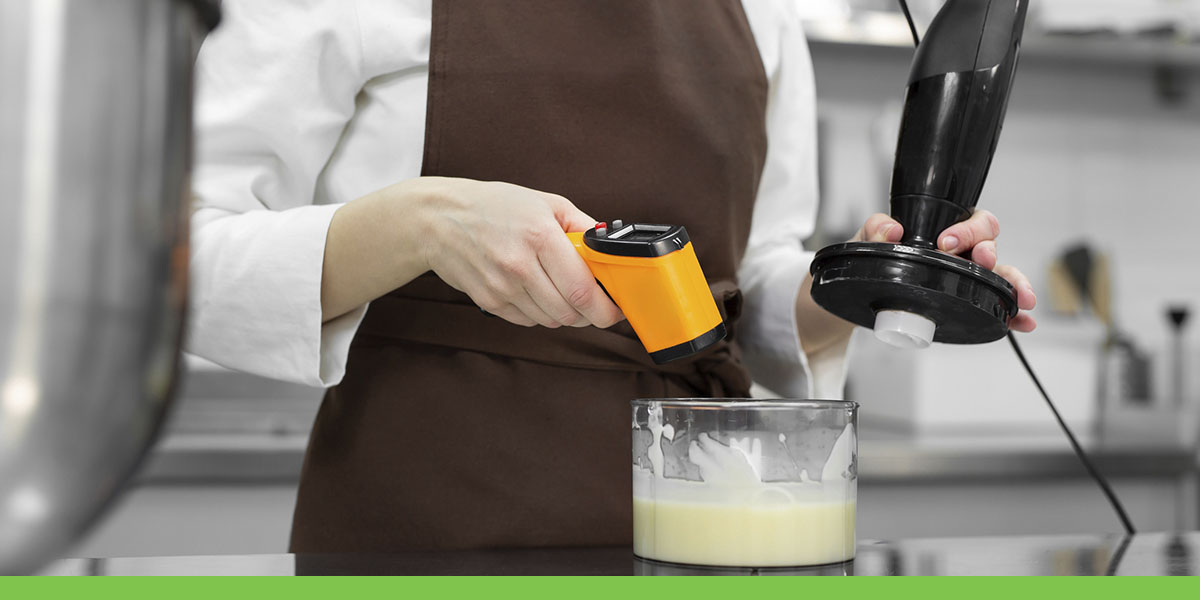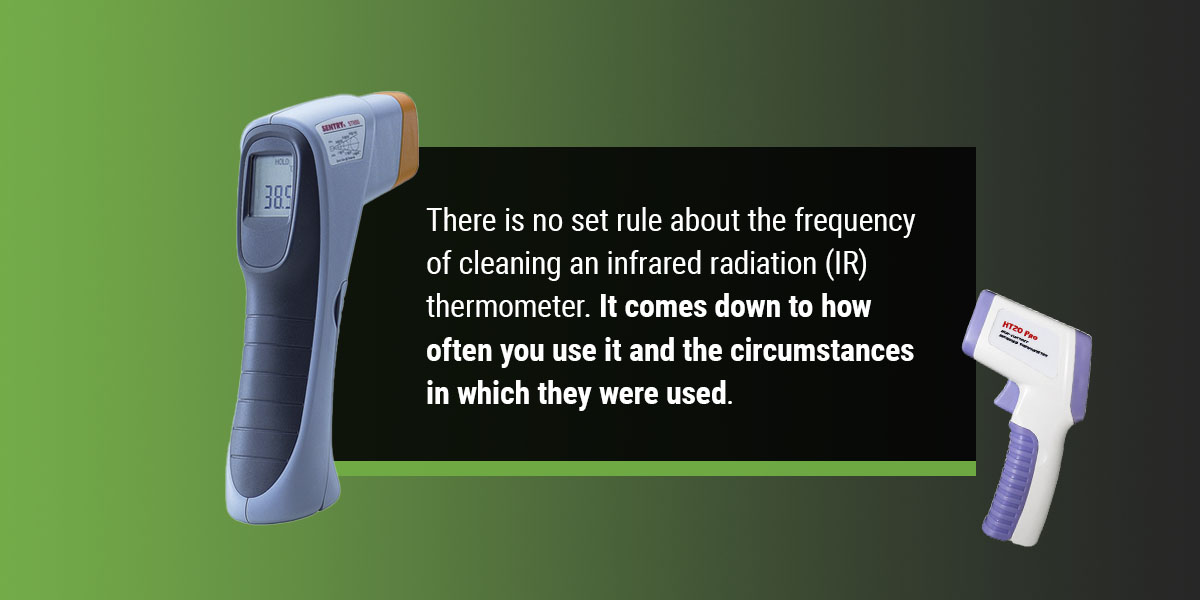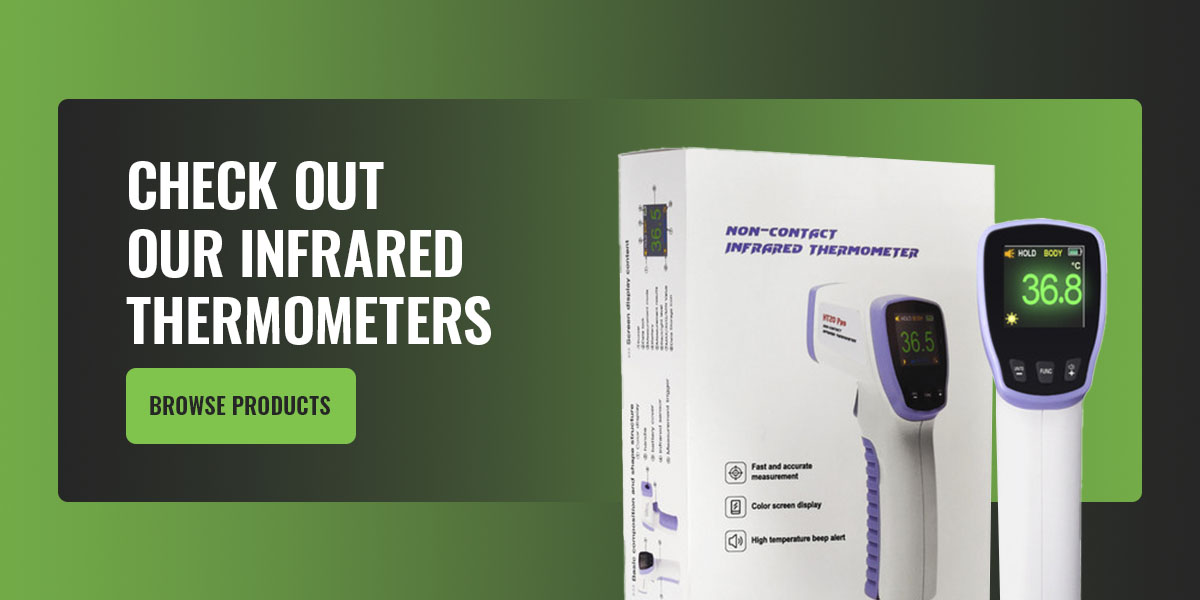How to Clean and Disinfect Infrared Thermometers
May 31st 2023

What Is an Infrared Thermometer?
An infrared thermometer is a non-contact measurement device that can check temperature readings from a distance. It works by reading an object's infrared energy. This energy directly relates to the object's temperature. The lens focuses on the infrared radiation and converts that energy into an electrical signal. The signal is then processed to calculate the temperature. The process happens within a few seconds before you get the accurate result.
Infrared thermometer guns can be used on physical objects like food and surfaces without touching them. They are also used to measure forehead temperatures in a work or home environment and are particularly useful in the food service and fresh produce industries. While infrared thermometers may not provide accurate readings on the internal temperature of items, it is effective in measuring the surface temperature of anything prone to contamination, impenetrable or hard to reach without the use of surface probes.
Regularly disinfecting and cleaning infrared thermometers ensures precise readings and keeps them in optimum functioning condition. Here's how to clean and care for your infrared thermometer so you can enjoy its extended use.
Step-by-Step Guide to Cleaning an Infrared Thermometer
Thermometers are versatile and can be used in varying environments. Exposure to dust, debris particles and grime is common if you need to measure the temperature of surfaces that move or are dangerous or frail. For example, checking the temperature of items on a conveyer belt in a factory or the heat of an industrial furnace from a distance may expose your thermometer to finite dust and other particles. This is especially evident if the thermometer is used in close proximity.
No matter what it is intended for, disinfecting and cleaning your infrared thermometer is quick and easy. Follow these steps:
- Always follow the manufacturer's guidelines for cleaning and disinfecting the thermometer without damaging it. Check for specific broad-spectrum disinfectants that can be used for wiping and cleaning. You shouldn't submerge the thermometer in any liquid unless instructed by the guidelines.
- Dab the tip of a clean, soft towel in a small dish filled with water or spirit solution. Never use soap or harmful chemicals. Ensure the material is not soaked but contains enough liquid so it does not enter any parts that could damage it inside.
- Gently wipe the lens clean of any dust or particles.
- Then, wipe down the rest of the thermometer.
- Let the thermometer and specifically the lens air-dry before you use it.

There is no set rule about the frequency of cleaning an infrared radiation (IR) thermometer. It comes down to how often you use it and the circumstances in which they were used. Regular use may require cleaning it more often, whereas using it every other day might only require cleaning once every six months. The point is to keep it clean after use and storage to ensure effective temperature readings when you need it.
Caring for Your Thermometer
While set requirements form part of your routine for cleaning a thermometer gun, other factors in caring for it will help keep it in good condition.
Remembering the following tips will keep your thermometer safe from damage:
- Avoid contact with and never submerge your thermometer in water
- Store it away from excessive heat and cold in a cool, dry location
- While in use, handle the thermometer with care to prevent damage and shock in case it drops
- Use a lanyard to keep your thermometer attached and reduce the risk of damage if it falls
- Try to avoid conditions that are damp, steamy, wet or smokey when taking temperature readings
- Understand the distance-to-target ratio for accurate readings and to maintain effectiveness
- Refrain from measuring through a surface to get a reading, like a glass pane, as you will get the glass surface measurement and not the element beyond
These tips are basic guidelines for caring for your thermometer, which you may use at your discretion.
Importance of Regular Checkups and Calibration
Checking your IR thermometer regularly and doing routine calibrations is vital in ensuring it performs optimally. Most come with a certificate or manual advising on the ideal calibration temperatures it should be set on. This is helpful for making a comparison when doing calibrations yourself or at a lab.
The FDA Food Code has specific requirements in place regarding thermometers and the calibration process. In the food industry, they are used to determine whether food is cooked to its ideal temperature. Cold and hot temperature checks are manual calibration techniques used by many as a quick and effective way of checking the accuracy of a thermometer.
If a thermometer provides false temperature readings, it could have severe consequences for the relevant industry. For example, if food is undercooked and an uncalibrated thermometer gives an inaccurate reading that it is cooked, it may lead to food poisoning and wastage. In turn, a company could be sued for damages, suffer insurmountable financial losses and be left with a tarnished reputation.
Emissivity and the Distance to Target Ratio
Understanding the importance of black bodies and their relation to emissivity and the distance-to-target ratio helps gain accurate measurements with an infrared thermometer:
- Black bodies: These are objects that absorb and emit electromagnetic radiation. A perfect black body emits light that is visible to the human eye. For example, the flame we see when a match is struck is a result of the soot particles that produce intense heat. The flame is the physical representation of the emitted heat. Hotter objects have shorter infrared wavelengths at which it peaks, which is when light becomes visible.
- Emissivity: Objects and materials have different energy radiation levels based on their composition and surface temperature. They generally have an emissivity value of 0 — for shiny, ultra-reflective surfaces like mirrors — to 1.00 — burning match or molten lava. Perfect black bodies have the highest intensity of 1.00. A value closer to 0 indicates a reflective surface that does not radiate heat and thus may not represent a true interpretation.
- Distance to target ratio (DTR): This ratio calculates the diameter of the targeted measurement area, usually an invisible circular area or spot, in relation to the distance between this targeted area and the point from which the infrared thermometer is held to take the reading. The diameter is calculated in inches as a D:T or D:S ratio like 12:2, for example, where the diameter circle or spot is 2 inches wide taken from a 12-inch distance.
Most thermometers are manufactured and preset at an emissivity rate of 0.95, close to that of organic objects. The closer the object's reading is to this, the more accurate it will be, although adjustments must be made to the thermometer according to the surface it is reading to achieve the desired result.
Keep in mind that measuring a larger surface area may provide an inaccurate reading since the temperature changes from the source when the distance is greater. The closer the range, the better results you are likely to record because the focus excludes fluctuating temperatures outside the target area core. The interrelated nature of these concepts makes them easier to understand through their connection to how infrared thermometers are used.
When to Replace an Infrared Thermometer
If your infrared thermometer is visibly damaged, it should be replaced. The infrared lens may be impaired, the motherboard chip could be dysfunctional, the connector may have come off or there could be other reasons it no longer works. Any irreparable damage indicates the need to replace the thermometer.
Check Out Our Infrared Thermometers
Looking for an infrared thermometer? We have a varied range to choose from among our temperature measurement tools! We offer ones that can be used for restaurant kitchens as well as others that are more industrial. We also have other thermometer types and temperature measurement devices you can select, including thermal imaging cameras, economy probe thermometers and premium probe thermometers.
Call us at (833) 471-1792 or complete a catalog request form to learn more.

